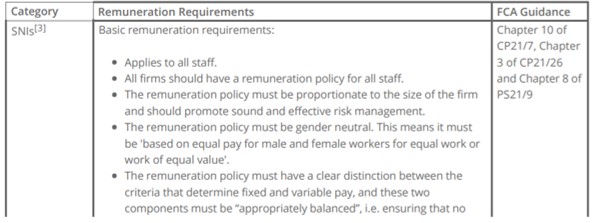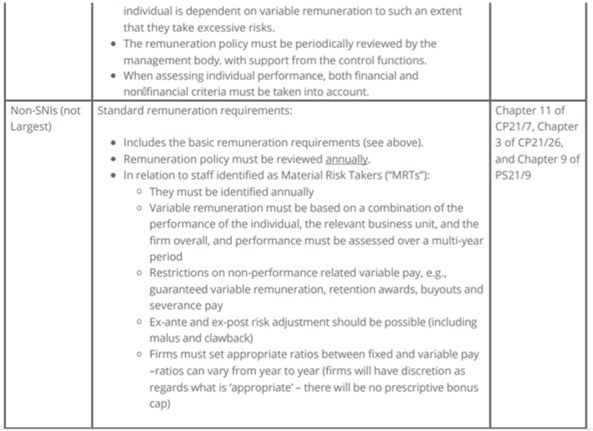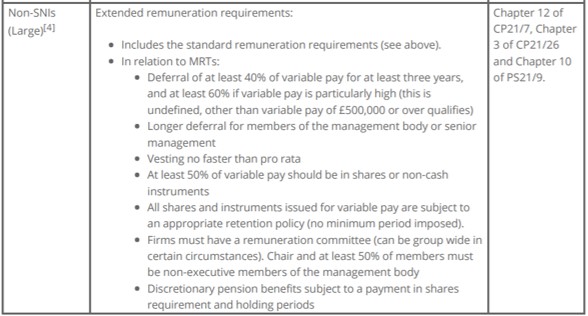Executive Pay
Executive Pay Watch: Financial Services: New MIFIDPRU Remuneration

Investment firms that come under the umbrella of the European Union's MiFID II directive - a regime that continues to apply to UK firms as MiFID II took force prior to Brexit - have a new remuneration code to contend with. This article delves into the details.
The UK's Financial Conduct Authority has now published its near final rules for the single remuneration code for MIFID investment firms.
The new code will replace the existing BIPRU and IFPRU
Remuneration Codes and will be known as the MIFIDPRU Remuneration
Code (“MIFIDPRU”). MIFIDPRU will apply to performance periods
beginning on or after 1 January 2022 and will require many firms
to implement changes to their reward policies and practices. A
copy of the FCA Policy Statement (PS21/9) containing the near
final rules can be
found here.
Background
MIFIDPRU is based on (but differs in some respects from) the
remuneration rules set out in the EU Investment Firms Regulation
((EU) 2019/2033) (IFR) and the Investment Firms Directive ((EU)
2019/2034) (IFD). The FCA’s stated objectives are to:
-- promote effective risk management in the long-term
interests of the firm and its customers;
-- ensure alignment between risk and individual reward;
-- support positive behaviours and healthy firm cultures; and
-- discourage behaviours that can lead to misconduct and poor
customer outcomes.[1]
MIFIDPRU will apply to performance periods beginning on or after
1 January 2022. Importantly the focus is on the ‘performance
period’ rather than the date on which remuneration is awarded or
paid out.
This means that firms currently subject to the existing IFPRU
and/or BIPRU Remuneration Codes should continue to apply those
rules in respect of remuneration paid in 2022 which relates to
performance or services provided during a period which started
before 1 January 2022.
Overview of the MIFIDPRU Remuneration Code
The extent to which the MIFIDPRU Remuneration Code applies to a
firm depends on how it is categorised under the new Investment
Firm Prudential Regime (IFPR). Broadly speaking, this
categorisation is based on a number of financial thresholds, the
details of which can be found in the FCA’s IFPR publications.[2]
There are three categories:
-- Smaller and non-interconnected firms (SNIs);
-- Non-SNIs; and
-- Largest non-SNIs.
We have summarised the main requirements in the table below (the
disclosure requirements are covered separately below).



Further Analysis
Gender-neutral
Some respondents to an earlier IFPR discussion paper queried why
the remuneration policy should be gender-neutral, since that is
already a requirement of the equal pay legislation. However, the
FCA wanted to include it to “support and reaffirm our aim to
drive healthy purposeful cultures in firms, which includes
developing an inclusive and diverse workplace."
[5]
This requirement will not impose any additional burden on
firms.
Conflicts of interest
The FCA have said that in order to mitigate the risk of conflicts
of interest arising, no variable remuneration should be awarded
to members of the management body who do not perform any
executive function in the firm, e.g. non-executive
directors.[6]
Disclosure requirements
The FCA requires certain remuneration information to be publicly
disclosed, namely:[7] the key characteristics of their
remuneration policies and practices; certain quantitative
disclosures about the remuneration outcomes of their staff; the
types of staff they have identified as MRTs (non-SNI firms
only).
In line with its approach to proportionality under the MIFIDPRU
Remuneration Code, a firm must disclose information in line with
its category under the MIFIDPRU Remuneration Code (see above).
Larger firms are expected to disclose more detail. Disclosures
need to be easily accessible and understandable by stakeholders,
so firms will need to publish their disclosures in an
easily-found part of their website and use easily-understood
language and diagrams, where relevant. Firms must publish their
disclosures annually, alongside their annual financial statements
(or annual solvency statement). Disclosures should be made more
frequently if a firm undergoes a significant change, e.g. a
merger or acquisition.
Material risk takers
MRTs are to be identified based on certain criteria. The FCA
said: “The aim is to identify all those individuals whose
professional activities can have a material impact on the risk
profile of the firm or the assets it manages. In conducting this
exercise, an FCA investment firm should consider all types of
risks involved in its professional activities. These may include
prudential, operational, market, conduct and reputational
risks.”
[8] There is no requirement to identify MRTs based on
remuneration alone, as this is not a reliable indicator of the
level of risk involved in a particular role within a firm.
Instead, the assessment will be made based on qualitative
criteria.
For large non-SNI firms to which the extended remuneration
requirements apply, MRTs are exempt from those rules if (i) they
receive variable remuneration of £167,000 or less, and (ii) that
variable remuneration makes up one third or less of their total
remuneration.[9] Both criteria must be met for the exemption to
apply. However, note that this exemption only applies with
respect to the extended remuneration requirements and the basic
and standard remuneration requirements will still apply to those
MRTs.
Malus and clawback
Firms must determine their own triggers for applying malus or
clawback. However, the FCA has said that malus should be applied
where i) there is reasonable evidence of employee misbehaviour or
material error, ii) the firm or the relevant business unit
suffers a material downturn in its financial performance, or iii)
the firm or the relevant business unit suffers a material failure
of risk management, and clawback should always be applied in
cases of fraud or other conduct with intent or severe negligence
which led to significant losses. For large non-SNIs, their
remuneration policies must include the possibility of applying
in-year adjustments, malus and clawback.[10]
Non-performance related variable
remuneration
The MIFIDPRU Remuneration Code includes rules and guidance on the
use of non-performance related variable remuneration, e.g.
guaranteed variable remuneration, retention awards, buy-out
awards and severance pay for MRTs.[11] Guaranteed variable
remuneration (also referred to as a “sign-on bonus” or “golden
handshake”) should only be awarded to MRTs rarely and not as
common practice, in the context of hiring a new MRT, in the first
year of service and where the firm has a strong capital base.
Retention awards are permitted but should be used only rarely
(e.g. in the context of specific projects) and should be awarded
only after the retention period has ended.
Buy-out awards involve a firm compensating a new employee whose
deferred variable remuneration was reduced by their previous
employer. Non-SNIs must ensure that the buy-out is aligned with
the long-term interests of their firm and remains subject to the
same pay-out terms required by the previous employer, e.g. by
following the same deferral and vesting schedule. Non-SNIs should
set out any criteria for determining severance pay in their
remuneration policy and all severance payments must reflect the
individual’s performance over time and must not reward failure or
misconduct.
Discretionary pensions benefits
For the purposes of the application of remuneration rules,
discretionary pension benefits are treated as a form of variable
remuneration. Under the new rules, all non-SNIs will be required
to ensure that all discretionary pension benefits are in line
with the business strategy, objectives, values and long-term
interests of the firm; award the full amount in shares,
instruments or within any alternative arrangements the FCA has
approved; and apply malus and clawback to discretionary pension
benefits in the same way as to other elements of variable
remuneration.[12]
In addition, under the extended remuneration requirements, if an
MRT leaves the firm before retirement age, non-SNIs must hold
these discretionary pension benefits for five years in the form
of shares, instruments or within any alternative arrangements.
Where the MRT leaves the firm upon reaching retirement age, the
pension benefits must be paid out in shares, instruments or
within any alternative arrangements and the MRT must retain them
for five years.[13]
Co-investments and carried interest
There are new rules on co-investments and carried interest [14]
and the FCA has confirmed that the MIFIDPRU Remuneration Code
applies to carried interest and that carried interest must be
valued at the time of its award.[15]
The FCA said they would not usually consider returns made by
staff on co-investment arrangements to be remuneration for the
purposes of its rules, but they would usually consider carried
interest to be remuneration.
Next steps
These are the steps firms should be thinking about ahead of 1
January 2022:
-- Assess which category of firm applies based on the
financial thresholds (e.g. SNI);
-- Consider whether remuneration policies and practices should be
reviewed and amended;
-- Non-SNIs will need to determine which individuals are MRTs
(which is likely to be wider than those carrying out;
-- senior management functions) and carry out a review of those
individuals’ remuneration.
-- Large non-SNIs will need to consider whether they meet the
requirements with respect to remuneration committees.
-- Careful analysis will be needed by firms that are part of
groups, including looking at applicable group consolidation
rules;
-- Multinational firms subject to MIFIDPRU Remuneration Code as
well as IFD and IFR remuneration rules in other jurisdictions
will need to consider issues such as the interaction of the
regimes and the extent to which employees outside the UK might be
caught by MIFIDPRU;
-- Firms will need to come to terms with the new disclosure
requirements and assess what needs to be disclosed and
when.
This article was first published in Thomson Reuters on Thursday 19 August 2021
Footnotes
[1] See para 9.7 of CP21/7
[2] For details of the categorisation of investment firms, see
section 2 of CP20/24, section 2 of PS21/6 and paras 2.17-2.19 of
PS21/9.
[3] For details of the definition of SNIs, see paras 2.3-2.11 of
CP20/24 and section 2 of PS21/6.
[4] A firm falls into this category if its i) on- and off-balance
sheet assets over a 4-year period have a rolling average of more
than £300m or ii) over the same period its on- and off-balance
sheet assets have a rolling average of more than £100m, and it
has a trading book business of over £150m, and/or derivatives
business of over £100m. For further details of these thresholds
and how they should be applied by firms, see para 9.22 of CP21/7
and section 7 of PS21/9.
[5] Para 10.11 of CP21/7
[6] Para 10.19 of CP21/7; SYSC 19G.2.12R
[7] Para 3.53 – 3.69 of CP21/26 (see Tables 3 and 4).
[8] Para 9.56 to 9.58 of CP21/7 and section 7 of PS21/9 sets out
more guidance on who should be characterised as a MRT.
[9] See paras 7.39 – 7.43 PS21/9. Note that the FCA has asked for
representations from stakeholders, so these figures might
change
[10] See paras 11.9 – 11.22 of CP21/7 and paras 9.17 – 9.19 of
PS21/9
[11] See paras 11.27 – 11.37 of CP21/7 and paras 9.22-9.30 of
PS21/9
[12] Paras 11.40 – 11.41 of CP21/7
[13] Paras 12.25-12.26 of CP21/7.
[14] See paras 8.11 – 8.17 of PS21/9 and guidance at SYSC 19G.4
for further details.
[15] Para 8.15 of PS21/9.